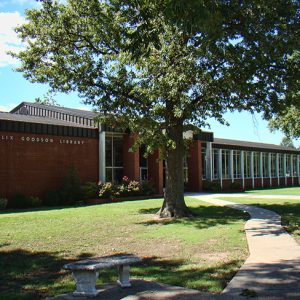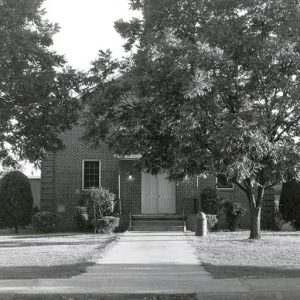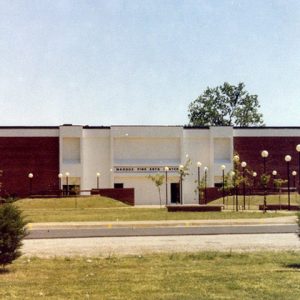calsfoundation@cals.org
Williams Baptist University
Williams Baptist University is a comprehensive liberal arts institution owned and operated by the Arkansas Baptist State Convention. Founded in Pocahontas (Randolph County) in 1941, the college was moved to Walnut Ridge (Lawrence County) in 1946. The university is one of two institutions of higher education affiliated with the Arkansas Baptist State Convention, the other institution being Ouachita Baptist University (OBU) in Arkadelphia (Clark County).
The impetus for the establishment of the university was first provided by Dr. Henry E. Watters, former president of Union University in Jackson, Tennessee, who had hoped to revive Jonesboro Baptist College, an institution that had failed during the early years of the Great Depression. During the mid-1930s, Watters attempted to enlist support for the re-establishment of the Jonesboro (Craighead County) institution. Among those he recruited to aid in the effort was Hubert Ethridge Williams, the young pastor of the First Baptist Church of Harrisburg (Poinsett County). When failing health forced Watters to abandon his campaign, Williams, by that time pastor of the First Baptist Church in Pocahontas (Randolph County), went forward with plans for a Baptist college in northeastern Arkansas. Williams aggressively cultivated support from many area residents for the proposed college. He found substantial encouragement from Jonesboro Baptist College alumni and from former students and supporters of Maynard Baptist Academy, another attempt at Baptist-sponsored education in the region, which lasted from 1900 to 1926. Williams’s relentless commitment to the cause culminated in the opening of the college, then named Southern Baptist College, on September 10, 1941, in Pocahontas. Originally, the college offered a two-year, liberal arts curriculum, and a majority of the college’s early students studied to become clergymen or public school teachers.
Crucial for the success of the new college was the enthusiastic interdenominational support of the Pocahontas City Council, which made available a new Works Progress Administration (WPA) community center as the home for Southern Baptist College. Not surprisingly, the trustees of the college selected H. E. Williams as the first president, a position he would hold for thirty-two years. Initially, the college depended almost exclusively upon tuition revenue and the support of individuals and churches. Significantly, in 1949, the college received an initial stipend from the Arkansas Baptist State Convention.
The progress of the new college was threatened when the institution’s principal building burned on December 26, 1946. However, the college was able to relocate to the decommissioned Walnut Ridge Army Flying School, and after a process of several years of extensive negotiations with the War Assets Administration, Williams gained partial ownership of the airbase property. Senator John McClellan and Representative Wilbur Mills advocated strongly for the college in its negotiations with the federal government. Over the next several decades, the college transformed the airbase through millions of dollars worth of new construction and renovations. Among the key supporters of this process was the Batesville (Independence County) entrepreneur J. K. (Jerome Kee) Southerland. In 1968, the college was formally adopted by the Arkansas Baptist State Convention, which provided significant and consistent annual financial assistance. To commemorate the singular, pivotal role played by H. E. Williams in the life and history of the college, and as part of the college’s fiftieth anniversary celebration, the name of the college was changed to Williams Baptist College in 1989.
The college maintained a substantive core of traditional liberal arts courses as the foundation of all its degree programs. In the early 1970s, Dr. D. Jack Nicholas, the second president of the college, and Dr. Jerol B. Swaim, the academic dean, began laying plans to transform the college into a baccalaureate institution. Their work culminated with the college’s development of baccalaureate programs in the early 1980s. During the first several years of its baccalaureate status, the college offered baccalaureate degrees in religion, education, and business. Subsequently, twenty-five more degree programs were added.
In 1995, former academic dean Jerol Swaim was named the fifth president. He followed Dr. Jimmy Milliken, who served from 1990 to 1992, and Dr. Gary Huckaby, who served from 1993 until Swaim’s appointment in July 1995. Building on the foundation of physical improvements and curricular expansion initiated during the tenure of President Nicholas, Swaim oversaw the college’s maturation into a comprehensive liberal arts institution. Moreover, during Swaim’s presidency, the college added three professorial chairs and two distinguished lecture series: the Vaughn Lecture in the Humanities and the Mondy-Carroll Lecture in Science. In 2012, Thomas Jones was chosen to succeed Swaim as president. In September 2017, the college announced that it was beginning the transition to university status. Jones announced his resignation in December 2017, and in March 2018, Dr. Stan Norman was named the new president.
Since its beginning in 1941, the university has provided all, or a substantial part, of the post-secondary education for more than 10,000 students. Arkansans made up a clear majority of these students, but several thousand students were drawn from other states, notably Missouri and Tennessee, and other countries. Of those foreign students who matriculated, the majority were from Africa, reflecting the special interest of the university’s founder. Students attend the campus in Walnut Ridge as well as enrolling in extension courses in Bradford (White County), Jonesboro, Piggott (Clay County), and Batesville. The student body, which averages about 500 each year, typically includes students from nearly a dozen states and several foreign countries. The university offers about twenty-five bachelor’s degree majors, with its largest degree programs in religion, education, business, psychology, and biology; it also offers a Master of Arts in teaching and a Master of Science in education. In the fall of 2019, the university enrolled 538 students and had more than twenty student organizations and eighteen varsity sports.
Somewhat contrary to the national trends for small denominational institutions, Williams has seen a marked growth in residence-hall population, with the university’s resident population representing over sixty percent of the total enrollment on the Walnut Ridge campus. In keeping with its denominational heritage and mission, the university requires all students to complete two Bible survey courses and to attend a weekly chapel service. The university currently works, in partnership with the Arkansas Baptist State Convention, in sponsoring humanitarian relief work in Haiti.
For additional information:
Hinson, Glenn E. A History of Baptists in Arkansas, 1818–1978. Little Rock: Arkansas Baptist State Convention, 1979.
Startup, Kenneth M. The Splendid Work: The Origins and Development of Williams Baptist College. Walnut Ridge, AR: Williams Baptist College, 1991.
Williams Baptist university. http://www.williamsbu.edu/ (accessed June 15, 2023).
Williams, C. Fred, Ray Granade, and Kenneth M. Startup. A System & Plan: Arkansas Baptist State Convention, 1848–1998. Nashville, TN: Providence House, 1998.
Kenneth M. Startup
Williams Baptist College
 Felix Goodson Library
Felix Goodson Library  Southern Baptist College Chapel
Southern Baptist College Chapel  Williams Baptist College Fine Arts Building
Williams Baptist College Fine Arts Building 




Comments
No comments on this entry yet.